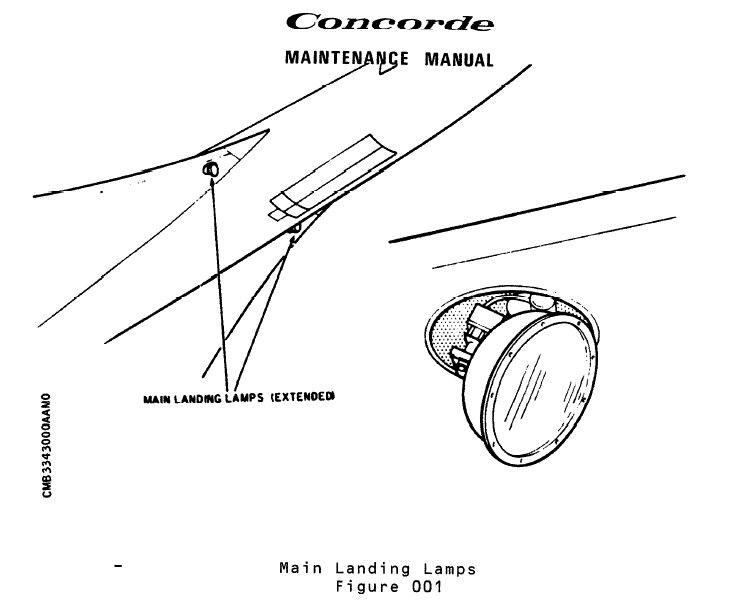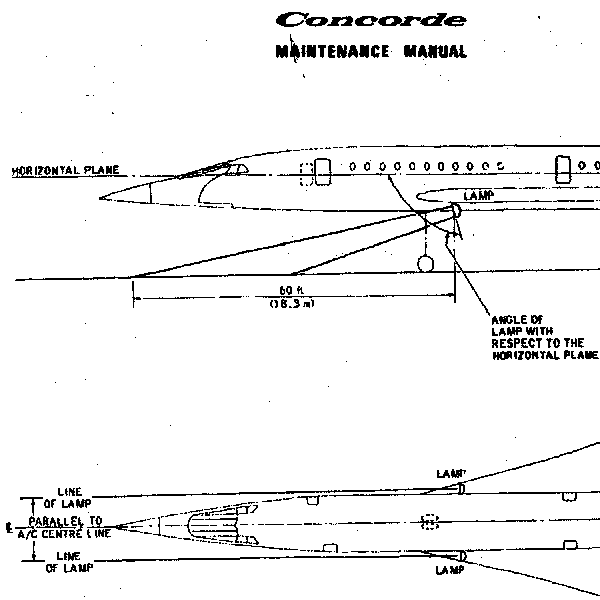28th Sep 2010, 21:57
permalink Post: 486
My question concerns lighting. Not many decent pictures showing landing lights etc being used in anger.
Concorde appears to have a much reduced frontal area for the housing of such lighting.
There is also the question of lenses having to withstand supersonic flow.
And also the angle of attack on landing (hope I have the right terminology there) seemingly pointing any lighting into the sky.
Cron
Concorde appears to have a much reduced frontal area for the housing of such lighting.
There is also the question of lenses having to withstand supersonic flow.
And also the angle of attack on landing (hope I have the right terminology there) seemingly pointing any lighting into the sky.
Cron
28th Sep 2010, 22:58
permalink Post: 492
Quote:
|
My question concerns lighting. Not many decent pictures showing landing lights etc being used in anger.
Concorde appears to have a much reduced frontal area for the housing of such lighting. |
Nevertheless there were three separate sets of landing/taxi lights there.
Quoting from the manual:
Two main landing lamps, one mounted in each wing root leading
edge, have retractable/extensible mountings and when not in
use are retracted in the lamp housing.
Two land/taxi lamps, similar to the main landing lamps, are attached to the
nose landing gear bay doors. The land/taxi lamps extend to
an intermediate position for landing, upon which they
automatically extend to the full position for taxiing, thus
changing the beam angle to compensate for the attitude change.
Two taxi/turn-off lamps, one mounted on each side of the
forward fuselage, provide ground illumination to identify
runway turn-off points.
These are the 'main' lights in the wing leading edge (600W each).

These are the lights in the nosewheel doors ("only" 450W each).

Quote:
| There is also the question of lenses having to withstand supersonic flow. |
The heat was less of a problem, actually.
The lights themselves were high-power sealed-beam units, the main units were 6 00W each, and the ones in the nosewheel doors were 450W ... nothing like your car headlights.
As a matter of fact, on the ground you were not suppossed to turn them on any more than 5 minutes in any 10 minutes.... they got a lot hotter when switched on, than they did in supersonic flight.
Quote:
| And also the angle of attack on landing (hope I have the right terminology there) seemingly pointing any lighting into the sky. |
What happened was that the main landing lamps in the wing roots were angled such, that they pointed straight ahead at the right angle to "hit" the runway during the landing itself.
Once the aircraft touched down, the land/taxi lights in the nose gear door extended further and lit a wider expanse of the runway ahead (see the earlier quote from the manual).
And then the third set of lights in the nose helped you to find the turn-off to the taxiway.
One nice little detail.... on F-BTSD, the Concorde at the French Le Bourget museum, those lights still work, and on G-BBDG, the Concorde at the Brooklands museum that was saved from the scrapheap, they brought those lights back to life, too.
CJ
Last edited by ChristiaanJ; 28th Sep 2010 at 23:14 . Reason: Addng pics and typo
29th Sep 2010, 09:43
permalink Post: 493
In service we tended to use only the wing-mounted main landing lights, as the nosegear door-mounted lights caused light buffeting which could be felt in the cabin.
They would, however, be pressed into service in really skanky conditions, or if it was felt they would help the aesthetics when a photographic detail was arranged.
They would, however, be pressed into service in really skanky conditions, or if it was felt they would help the aesthetics when a photographic detail was arranged.
29th Sep 2010, 14:38
permalink Post: 496
Quote:
|
In service we tended to use only the wing-mounted main landing lights, as the nosegear door-mounted lights caused light buffeting which could be felt in the cabin.
|
Judging by the picture from the maintenance manual below, once the nosewheel was down, the main landing lights just lit up the ground below the nose, but not ahead.
Did you just rely on the runway lighting plus the ambient light (town lights reflected by the clouds, etc.) or did you usually extend the nosewheel door lights once you were down?

CJ
29th Sep 2010, 15:25
permalink Post: 497
We either switched to the taxy lights or just carried on with the taxy/turn lights which were often ample.
14th Oct 2013, 23:34
permalink Post: 1723
PJ2 reminds us of the way the airframes of other a/c queuing for take-off would resonate as Concorde departed. Whether it was the responsibility of SNECMA or Rolls Royce (or even Bristol Siddeley?
 ), the reheat was certain to set off a random sprinkling of car alarms on the airfield, which used to make my day when lucky enough to be returning to the car park around midday at LHR.
), the reheat was certain to set off a random sprinkling of car alarms on the airfield, which used to make my day when lucky enough to be returning to the car park around midday at LHR.
Even without reheat, however, the engine had a distinctly military sound - quite unlike other civil turbojets I can remember. The sound of it in the descent at about 4000ft over my house at 5 pm daily was unmistakeable. On the approach, if you weren't expecting it, it could be quite unnerving. One night in the late 1970s, during a long car journey, I stopped for a call of nature at a well-known public house near Hatton Cross (about a mile from touchdown on LHR 27L). It was pitch dark, and I decided that the hedge at the side of the car park would be a suitable venue. Never having heard Concorde on the approach before, I became increasingly nervous as the sound, initially unidentified, got progressively louder. And then the landing lights were switched on...
 ), the reheat was certain to set off a random sprinkling of car alarms on the airfield, which used to make my day when lucky enough to be returning to the car park around midday at LHR.
), the reheat was certain to set off a random sprinkling of car alarms on the airfield, which used to make my day when lucky enough to be returning to the car park around midday at LHR.
Even without reheat, however, the engine had a distinctly military sound - quite unlike other civil turbojets I can remember. The sound of it in the descent at about 4000ft over my house at 5 pm daily was unmistakeable. On the approach, if you weren't expecting it, it could be quite unnerving. One night in the late 1970s, during a long car journey, I stopped for a call of nature at a well-known public house near Hatton Cross (about a mile from touchdown on LHR 27L). It was pitch dark, and I decided that the hedge at the side of the car park would be a suitable venue. Never having heard Concorde on the approach before, I became increasingly nervous as the sound, initially unidentified, got progressively louder. And then the landing lights were switched on...
